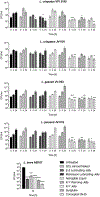Clinical and Personal Lubricants Impact the Growth of Vaginal Lactobacillus Species and Colonization of Vaginal Epithelial Cells: An in Vitro Study
- PMID: 32842049
- PMCID: PMC8793461
- DOI: 10.1097/OLQ.0000000000001272
Clinical and Personal Lubricants Impact the Growth of Vaginal Lactobacillus Species and Colonization of Vaginal Epithelial Cells: An in Vitro Study
Abstract
Background: Vaginal lubricants are commonly used during gynecological examinations, during sexual activities, or to alleviate vaginal dryness. Many lubricants contain potentially bacteriostatic or bactericidal agents (parabens, chlorhexidine gluconate, nonoxynol-9). Our objective was to evaluate the impact of lubricants that vary in formulation on the growth and viability of vaginal Lactobacillus species and vaginal epithelial cell (VEC) colonization in an in vitro model.
Methods: Growth curve, disk diffusion, and minimal inhibitory assays were used to determine the impact of lubricants or excipients on the growth of Lactobacillus crispatus, Lactobacillus gasseri, Lactobacillus jensenii, and Lactobacillus iners. L. crispatus strain was used in VEC colonization assays. Statistical differences were determined by analysis of variance.
Results: Lubricants containing chlorhexidine gluconate or nonoxynol-9 (N-9; Conceptrol, K-Y Jelly, and Surgilube) significantly inhibited Lactobacillus species growth (P < 0.05). In contrast, other clinical lubricants (E-Z Lubricating Jelly, McKesson Lubricating) and personal lubricants (Astroglide Liquid, Good Clean Love Almost Naked, K-Y Warming Jelly) did not exhibit this effect. Chlorhexidine gluconate had a detrimental effect on Lactobacillus growth and exhibited stronger antimicrobial activity compared with methylparaben and propylparaben (P < 0.0001). There were lubricants that did not induce cytotoxicity in VEC (Good Clean Love Almost Naked, E-Z Lubricating Jelly, McKesson Lubricating Jelly), but these products did substantially decrease the attachment of L. crispatus to VEC, particularly when VEC were preexposed to lubricants before inoculation with bacteria (P < 0.0001).
Conclusions: This in vitro model indicates that select vaginal lubricants, particularly those with chlorhexidine gluconate, have potentially adverse effects on women's health by reducing growth and recolonization of vaginal Lactobacillus species.
Conflict of interest statement
Potential conflicts of interest
The authors declare no conflict of interest.
Figures




References
-
- Herbenick D, Reece M, Schick V, Sanders SA, Fortenberry JD. Women’s use and perceptions of commercial lubricants: prevalence and characteristics in a nationally representative sample of American adults. J Sex Med. 2014; 11(3):642–652. - PubMed
-
- Crean-Tate KK, Faubion SS, Pederson HJ, Vencill JA, Batur P. Management of genitourinary syndrome of menopause in female cancer patients: a focus on vaginal hormonal therapy. Am J Obstet Gynecol. 2020; 222(2):103–113. - PubMed
Publication types
MeSH terms
Substances
Supplementary concepts
Grants and funding
LinkOut - more resources
Full Text Sources
Other Literature Sources
Molecular Biology Databases

